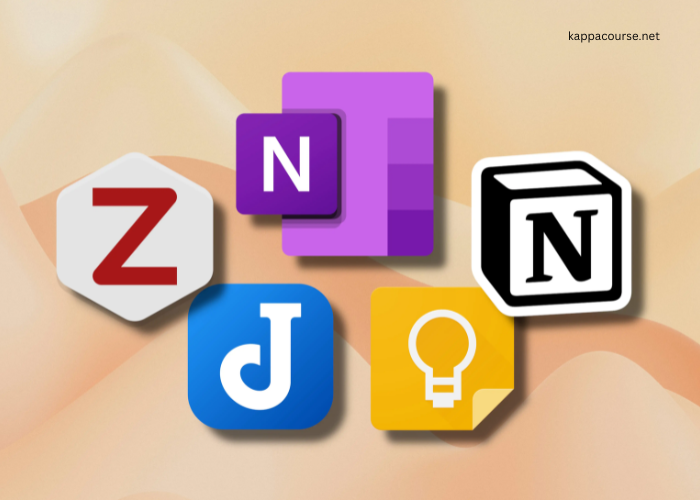College students need efficient note taking apps to capture and organize their class materials. Digital platforms help students store, search, and review information quickly. Modern note taking apps offer features like cloud sync, collaboration tools, and multimedia support.
Students face challenges when picking the right notes app. Many apps exist with different features and price points. Some apps work better for specific subjects or study methods. Today, we will help you select the best app for their needs.
Research shows digital note taking improves learning outcomes. Studies indicate students who use notes apps achieve better grades. The right app helps you stay organized and study more effectively.
Essential Features in College Note Taking Apps
Noting apps must have specific features to serve college pupils well. Cloud sync keeps notes accessible across devices. Search functions help you find information quickly. Organization tools like folders and tags help manage course materials.
Cross-platform support allows one to take notes on any device. Many students switch between laptops, tablets, and phones throughout their day. The best apps work seamlessly across all platforms.
Offline access proves crucial for college students. Internet connections can be unreliable in lecture halls. Top notes apps let students continue working without internet access.
Top Note Taking Apps for College Students
1. OneNote for All in One College Notes
Yes, it’s not Apple Notes or the extremely hyped Notion. OneNote stands out as Microsoft’s premier note taking solution. The app integrates seamlessly with Office 365, which was the main factor behind it taking the top spot. This deep integration makes OneNote a natural choice for academic work.
Microsoft Office is absolutely essential for students, and if you can instantly access your notes with it, it will take your academic performance up to a whole new level. Most college students these days use Microsoft Office for Mac, as it’s the highest performing laptop right now.
Back to OneNote – it’s the app that also excels at handwritten notes and drawings. STEM majors praise the infinite canvas feature. OneNote lets users write equations and draw diagrams naturally.
Class recordings sync perfectly with notes. Users can review lecture audio alongside written content. The powerful search function finds text in images and handwriting.
OneNote’s organization system mirrors physical notebooks. Create separate notebooks for each class. Sections and pages help organize topics logically.
2. Notion for Flexible Academic Note Taking
Notion leads to customizable notes. Users create personalized workspaces for different courses. The app combines notes, tasks, and project planning effectively.
The free plan includes essential features for college work. Notion’s interface adapts to various noting styles. Users build linked databases to connect course materials.
Templates accelerate note creation in Notion. The academic community shares course-specific templates. These frameworks help organize study materials efficiently.
3. Evernote for Organized Study
Evernote offers strong organization tools. The tag system helps sort materials by course and topic. The web clipper saves research materials instantly.
Advanced search capabilities help during exam preparation. Evernote searches text within images and PDFs. Users attach files to notes for complete course organization.
The app excels at document scanning. Quickly digitize handwritten notes. Character recognition makes handwritten text searchable.
4. GoodNotes for Digital Handwriting
GoodNotes focuses on handwritten digital notes. The app shines on tablets with stylus support. Write naturally while enjoying digital benefits.
The app converts handwriting to text accurately. This feature helps share neat notes with classmates. GoodNotes organizes notes in customizable notebooks.
Math and science majors value the precision tools. The app includes shapes and graph paper templates. Create professional-looking diagrams easily.
5. Bear for Clean, Simple Notes
Bear provides a distraction-free writing environment. The app uses markdown for easy formatting. Focus on content instead of complex features.
The organization system uses hashtags. Tag notes with course codes and topics. This flexible system adapts to different study methods.
Bear excels at quick note capture. Jot down ideas and organize later. The app syncs rapidly across Apple devices.
6. Obsidian for Connected Learning
Obsidian transforms note taking through linked thinking. The app creates connections between related concepts. Students discover relationships in course materials.
The markdown-based system works offline first. Users own their notes as local files. This ensures long-term access to materials.
Build knowledge networks across subjects. Biology notes link to chemistry concepts naturally. These connections help understand complex topics.
The community creates powerful plugins. Automate common noting tasks. Obsidian grows more useful throughout college years.
7. Notability for Active Learning
Notability combines handwriting and audio recording. Record lectures while taking notes. The app syncs audio with written notes perfectly.
The handwriting experience feels natural. Write and draw with precision. The app converts handwritten math equations to text.
The organization system stands out. Dividers separate subjects and semesters. Auto-backup protects important notes.
8. Apple Notes for Simple Tasks
Apple Notes provides free, reliable note taking. The app comes pre-installed on Apple devices. Start taking notes without setup.
Recent updates add academic-friendly features. Scanning documents works quickly. The tag system helps organize course materials.
The app syncs reliably across Apple devices. Access notes on phones and laptops. Sharing notes with classmates takes one tap.
9. Roam Research for Complex Subjects
Roam Research excels at interconnected notes. Create bidirectional links between concepts. This helps understand complex course material.
Daily notes capture class information chronologically. Reference previous lectures easily. The system builds a personal knowledge database.
The outline format suits academic writing. Organize research papers efficiently. Citations and sources stay connected to notes.
10. RemNote for Active Recall
RemNote combines notes with active recall. The app creates flashcards from notes automatically. This feature promotes effective studying.
The hierarchical structure organizes complex topics. Break down difficult concepts. Visual learning tools support understanding.
Spaced repetition assists long-term memory. Review materials at optimal intervals. This improves retention of course content.
Real Student Experiences with Note Taking Apps
Recent surveys reveal student preferences. Engineering students favor OneNote’s drawing tools. Humanities students appreciate Notion’s flexibility for writing papers.
Students report grade improvements after adopting digital notes. Better organization leads to more effective studying. Quick search functions save time during exam preparation.
Collaboration features enhance group work. Students share notes and create study guides together. Digital formats simplify group project management.
Cost Considerations for College Noting Apps
Free plans satisfy most student needs. Basic note taking features come standard. Premium features add value for specific requirements.
Student discounts reduce costs significantly. Many apps offer educational pricing. Some colleges provide premium accounts to students.
Long-term storage needs affect app choice. Free storage limits vary between apps. Students should consider future storage requirements.
Advanced Note Taking Strategies
Digital Organization Tips
Students should create consistent naming systems. Course codes help identify materials quickly. Clear folder structures speed up note access.
Regular backups protect academic work. Students export notes monthly. Multiple backup locations ensure note safety.
Tags help connect related materials. Students tag notes with themes and concepts. This creates flexible organization systems.
Maximizing App Features
Students should explore keyboard shortcuts. Quick commands save time during lectures. Efficiency increases with practice.
Template usage streamlines note creation. Students prepare layouts for different classes. This maintains consistent note organization.
App-specific features enhance learning. Audio recording helps in large lectures. Handwriting works best for math problems.
Making the Final Choice
Students should consider their study style. Visual learners need drawing tools. Text-focused students want fast typing support.
Course requirements influence app selection. Science classes need equation support. Literature courses benefit from annotation tools.
Testing apps before buying saves money. Free trials show real usefulness. Students can switch apps between semesters.
Future of College Note Taking
New features emerge regularly. AI assists with note organization. Voice-to-text improves lecture capture.
Cross-app integration grows stronger. Notes connect with research tools. Calendar apps link to study materials.
Mobile devices become more capable. Tablets replace paper notebooks. Phones capture quick ideas instantly.
Conclusion
Selecting the right notes app impacts academic success. Students should evaluate their specific needs. The best app matches individual study habits.
Regular app updates add useful features. Students benefit from improving tools. Digital notes continue to evolve.
Free options serve most student needs well. Premium features help specific cases. Students should start simple and upgrade when needed.



